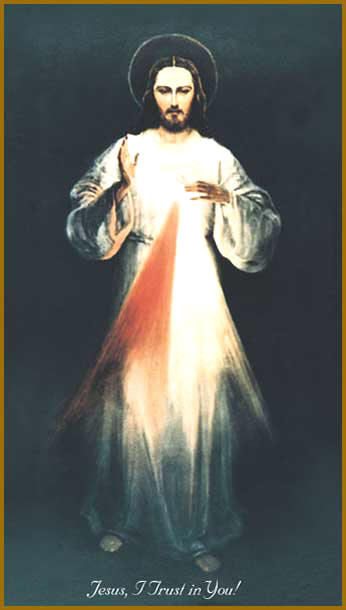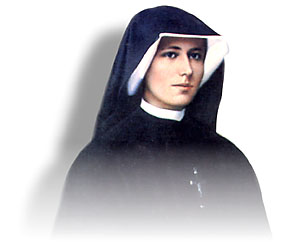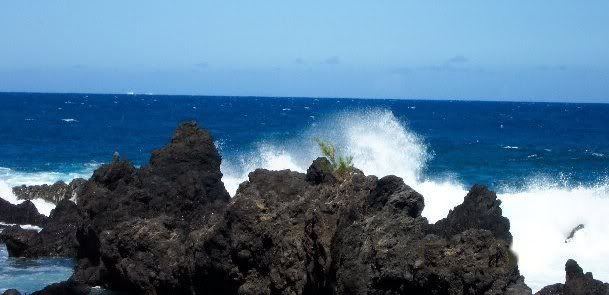April 22, 2006
Ocean's of Mercy~ The story of Divine Mercy Sunday

The Divine Mercy picture, by Vilnius painter Eugenijus Kazimierovskis. Image based on a vision received by St Maria Faustina Kowalska in 1936
She was the daughter of Polish peasants, with just enough education to read some, sign her name, and do basic math. She felt a deep religious calling so without permission, or financial resources she left her family and was received into a convent in Warsaw Poland, Over the next few years, the young sister showed a depth of devotion and a grasp of the matters of faith beyond one like herself.
After a period of spiritual crisis often called "a dark night of the soul" Sisiter Faustina began to receive impressions of the Holy Spirit. Our Lord revealed to her that He wanted to pour out His Grace and Mercy on the whole world and "that all of the sins of mankind were as a drop in the Ocean of God's Mercy..." She was also told to paint a picture depicting our Lord Jesus as you see above with the red and white rays symbolizing divine grace and mercy pouring forth. She was also give a prayer to pray to intercedeed for the deliverance of the entire world

St Faustina,
here is a short article on herVery young and not even fully professed as a nun, she was not believed. However her confessor, and her mother superior had her examined physically and mentally and found that Faustina was mentally and physically sound. They had her begin to keep a diary, which she did out of obedience. This helped her grow in her skill as a writer, and as one reads her diary you can see how she can more and more tell us what she was experiencing. Soon, her Mother Superior was convinced of the authenticity of her revelations as was this priest. He had the picture painted, and it was hung and accepted, even venerated by people who were touched by the vision of a loving God that wanted to love and forgive.The reverend Mother and her nuns began to pray the Chaplet of Divine Mercy...and eventually Sister Faustina was moved from Vilnius, Lithuania, to Krakow, Poland to Warsaw, Poland to Katoweitza (sp)Poland, and the Chaplet spread. The religious of Poland were praying
Eternal Father, I offer You
The Body Blood Soul and Divinity
Of your dearly beloved Son
Our Lord, Jesus Christ
In attonment for our sins
and those of the whole world
For the Sake of His sorrowful passion
Have mercy on us and on the whole world...
They needed that prayer, because Poland was about to become the epicenter of the worlds greatest war, its most hideous genocide...perhaps the world survived because this nun was obedient and "wrote down what she saw, and was obedient to the last..." we will never know this side of Glory. But the impact on the Catholic Church is visible and through it the impact on the world continues even to this day, as a renewal of faith in Jesus and the knowledge that a personal relationship with our Lord is required of each of us.
While in Warsaw, the prayer was learned by by a young Polish priest, who taught his congragants the Chaplet, believing that the message was vital to salvation of the soul and of the world. It is said that this priest,Father Maximillian Kolbe taught this prayer to fellow prisoners and when a group of prisioners were to be taken to the execution pits, he volenteered to fill the place of a man "who had a family", and spent 10 days slowly starving to death. He was still alive after the ten days and was finished off with a lethal injection of carbolic acid. Father Kolbe was cannonzed as a saint in 1982
In Krakow, the Chaplet was new and exciting and young people espcially students embraced it. One of these we are told was a young university student named Karol Wojtyla. The rest is history. Wotyla, as a priest, bishop and later as Pope John Paul II, has a profound impact on the Christain world of the 20th century. His was a message of God's mercy and grace. He professed this faith in a personal touchable reachable Saviour, in a culture of persecution, first under the Nazi's then the Communists. He saw unimaginable suffering and later experienced this himself both relationally and in his own body as he struggled with phsically infimity...That we as believers were to love and forgive our enemies, and ourselves...
Here is an article on how culture shaped the Holy Father's message which is a different look at him and his mission... Both Catholic and Non Catholic Christian would benefit by reading his encyclicals (theological studies)particularly on human relationships and world evangelization. Much of his world view and faith was influenced by the idea of a merciful loving God rather than the wrathful vengful God of the past. On having a personal relationship with Jesus Christ rather than just going through the motions of religion.
We as non Catholics can learn from Faustina's humility, and willingness to be a fool for Christ's sake. I think its too bad that we dont celebrate Divine Mercy Sunday as a part of Easter and use the day to focus on the love and mercy of Jesus, and to share that forgiveness of every sin can be found in Jesus... As St. Faustina wrote, Then He (Jesus) said..."how I long to embrace every person in the world and show them my love and mercy, that my forgiveness is complete and boundless. Oh that all would come, there is room at My table for everyone..."
